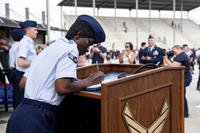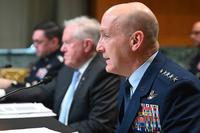As the U.S. Navy crews of two riverine command boats were being held on Iran's Farsi island by members of the Revolutionary Guard, their captors began to interrogate the group, demanding to know where the Navy "mothership" was.
The ten crew members insisted on the truth -- that there was no mothership, and the 50-foot boats were making a transit of 250 nautical miles from Kuwait to Bahrain on their own.
Reportedly, the captors were incredulous, telling the group they didn't believe the boats could make the distance on their own.
"Yeah," at least one of the Navy crew members reportedly laughed. "I wish you could tell my people that, because we told them these boats can't do that."
This exchange, revealed for the first time in a Navy command investigation made public Thursday, highlights many of the key findings regarding the circumstances that led to the 15-hour detention of the ten sailors Jan. 12.
The 170-page probe found shoddy training, poor preparation, communication gaps and leadership failures all were to blame for the international incident, which was manipulated into a propaganda victory by the Iranians.
Among other discoveries, the investigation found that members of the riverine boat crews had been up all night before the planned transit attempting to repair the poorly maintained boats, a violation of policies requiring ample rest before journeys of that length.
They determined that the sailors had unknowingly passed through Saudi Arabian territorial waters before accidentally entering Iranian territorial waters. And they found the sailors had committed multiple code-of-conduct violations while detained, demonstrating a lack of understanding of policy and insufficient training.
In all, the investigation recommends that eight Navy officers and petty officers be held accountable for leadership and conduct failings in the incident.
Transit Gone Wrong
According to the investigation, the transit of the two riverine boats, assigned to Coastal Riverine Squadron 3 began in the afternoon Jan. 12. The boats were ordered to transit from Kuwait to Bahrain to support an upcoming military exercise, a longer distance than the crews, or anyone from the squadron, had ever covered before in the vessels.
The boats planned to meet up with the Coast Guard Cutter Monomoy before sunset to refuel, and altered their course as soon as they got underway to reach the cutter faster, but without notifying anyone of their plans, according to the investigation.
From the outset, communications were a problem. The second riverine boat, 805, eventually established satellite communication with officials from the parent unit, Task Force 56.7, in Bahrain. The lead boat, 802, never established satellite communication.
Shortly into the journey, just before 3:30 p.m. local time, the boats unknowingly entered and passed through Saudi Arabian territorial waters. Just after 3:45 p.m., they entered Iranian waters around Farsi Island, which lies between Saudi Arabia and Iran in the Persian Gulf. The Monomoy, monitoring the journey, notified task force officials that the boats appeared to be in Iranian territorial seas.
Fewer than 30 minutes after the boats entered the region, boat 802 discovered a loss of lube oil pressure. The two boats decided to go "dead in the water" to investigate the engine issue, just 1.5 nautical miles south of Farsi island.
Minutes later, two small Iranian boats approached, crew-mounted weapons pointed at the riverine boats. Some of the riverine crew members went to man their own crew-mounted weapons, but the captain of the lead boat, a Navy lieutenant and the only officer in the group, waved them off in an attempt to de-escalate.
Sailors Detained
As Iranian troops racked their weapons and pointed AK-47s and .50-caliber guns at the sailors, the officer made another attempt to extricate the boats from the worsening situation, ordering the lead boat's coxswain to accelerate through the Iranian boats in a getaway attempt. But the coxswain disregarded the order, telling investigators later that he thought members of the crew would be killed if he followed it.
Two additional Iranian boats arrived, and members of the guard boarded the riverine boats, tearing down the American flags they were flying and hoisting Revolutionary Guard flags in their place. They blindfolded the sailors, taking their personal belongings and tying their hands together with pieces of Iranian flag, according to the report.
Then the guided the two riverine boats to Farsi island, where the sailors would spend their brief period as detainees.
The ten sailors were kept together in a room, where they were first interrogated together, then one-by-one, in sessions ranging from 15 minutes to two hours. Iranian captors would bring in food and attempt to film the sailors with a video camera as they ate. The lead boat captain resisted these efforts to film the crews, but ultimately told the sailors they should eat because it wasn't clear when their next meal was coming.
In perhaps the most significant misstep during this period of detention, the lead boat commander agreed to read scripted remarks on camera in front of an Iranian "news crew" in which he apologized for the mistake of ending up in Iranian water and said the incident was "our fault." He did this in exchange for the promise of release, the investigation found, against military code of conduct rules for such situations. Unbeknownst to him, the release of all the sailors had already been secured by the U.S. government and their departure from Farsi island was imminent.
Contributing Factors
Because of unit upheaval and reorganization in previous years, Coastal Riverine Squadron 3 and its parent unit, Coastal Riverine Group 1, found themselves undermanned and overtasked. The crews of the two command boats had missed key skills training periods due to operational commitments, the investigating officer found, and were lacking navigation training as well as training needed to prepare them to operate in the Middle East during their deployment.
Poor communication meant that the then-commander of Task Force 56, Capt. Kyle Moses, didn't realize the units were inadequately prepared for deployment, the investigator found. On top of that, the investigation determined, the task force fostered a "can't say no" command climate, meaning that lower-ranking troops fell in line rather than raising important concerns.
Neither Moses, nor the commander of Task Force 56.7 in Bahrain, nor the Kuwait detachment officer-in-charge, understood the poor condition of the riverine command boats, neither of which was fully operational, the investigation found. Neither task force had a sense of ownership of the boats, officials said.
This lack of leadership and training was considered by investigator to be an extenuating factor in the conduct of the riverine boat crews, which made a series of bad choices starting with "blindly" deviating from course at the outset.
The two boat captains did not understand proper procedure for addressing an engine failure underway. They failed to keep their weapons manned while dead in the water to guard against a surprise attack. Both captains failed to exercise self-defense when the Iranians demonstrated hostile intent, the investigation found, due to a lack of understanding of how to do so. The lead boat captain surrendered both boats to the Iranian authorities, the probe found. While the military code of conduct acknowledges that troops may be captured, it forbids surrender if they have the means to resist.
And while detained, the crews showed some confusion about what they were permitted to say. The investigator found some volunteered pieces of information apart from name, rank and serial number, including the top speed of the riverine boats and the fact that the parent command owned a third boat. The sailors' comment about telling their command the boats couldn't make the journey demonstrated lack of trust in their chain of command to the detaining forces, the investigator said, and could have been used for propaganda purposes.
Discipline and Recommendations
Despite the missteps of the captain of the lead boat, the investigating officer accounted for his junior rank and lack of fleet experience and oversight, recommending only that a copy of the investigation be forwarded to his commander for appropriate oversight.
"He was placed in a difficult position, albeit one in which his own actions placed him and nine other sailors in danger," the investigating officer wrote. "His deployment to the Fifth Fleet area of operations lacked any form of oversight and he lacked basic mentorship and development from his entire chain of command. Left to his own devices, he emulated the poor leadership traits he witnessed firsthand within his own chain of command."
The report also recommends discipline for the commander of the second boat and the coxswain who disobeyed the order to accelerate away, asking that the investigation be forwarded to their chain of command for action.
Discipline is also recommended for Task Force 56 Commander Moses, the Task Force 56 chief staff officer, the commanding officer and executive officer of Coastal Riverine Squadron 3, and the Kuwait officer-in-charge at the time of the transit.
The Navy announced that CRS-3 executive officer Cmdr. Eric Rasch had been relieved from his post in May. Moses was relieved earlier this month. Actions regarding the other officers have not been made public to date.
The investigating officer also recommended an immediate operational training and readiness stand-down for Task Force 56 to ensure adequate training and readiness, as well as the implementation of monthly live-fire training and a review of policies and procedures for maritime operational centers.
In view of the confusion surrounding who was in charge and the chain of command once the riverine boats got underway and the lack of familiarity with the boats' capabilities, the investigator recommended developing a career track "specifically for the competitive selection and detailing of post-department head surface warfare officers to officer-in-charge billets at the coastal riverine squadrons."
The report casts a strongly unfavorable light on the actions of the Iranian guards, who the investigating officer found accosted and detained U.S. sailors in an innocent passage through territorial waters, against international norms. The riverine boats were inappropriately searched and communications wires cut, the probe found. And many of the sailors who were interrogated had their personal space invaded during periods of questioning as Iranian interrogators sought to intimidate them into giving up information.
These findings appear to run somewhat counter to remarks from Secretary of State John Kerry, who negotiated the sailors' release and thanked Iranian authorities for their quick response.
"All indications suggest that our sailors were well taken care of, provided with blankets and food and assisted with their return to the fleet," Kerry said Jan. 13.
In a largely damning report, there are a few commendations. The investigating officer recommended that the No. 2 gunner aboard the second riverine boat -- the only female sailor among the ten detained -- be recognized for her quick thinking in activating an emergency beacon while "kneeling, bound and blindfolded" at Iranian gunpoint, in a brave but ultimately thwarted attempt to call for help.
The commanders and crews of the cutter Monomoy and the guided-missile cruiser USS Anzio, which coordinated to track the captured sailors and provided assistance on their return, were also recommended for special recommendation.
Chief of Naval Operations Adm. John Richardson was expected to discuss the findings of the investigation on Thursday.
--Hope Hodge Seck can be reached at hope.seck@military.com. Follow her on Twitter at @HopeSeck.



























